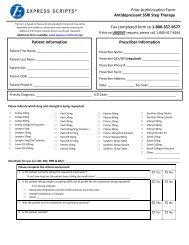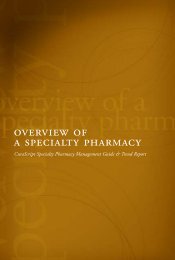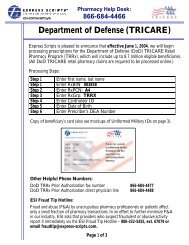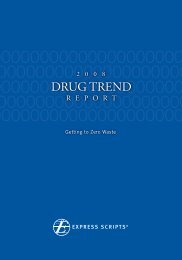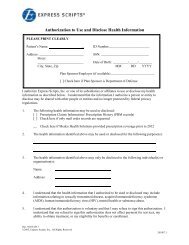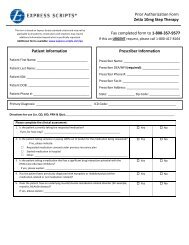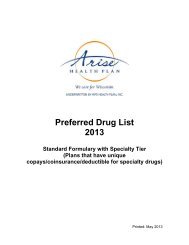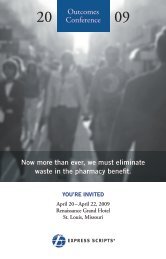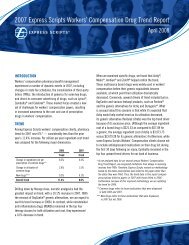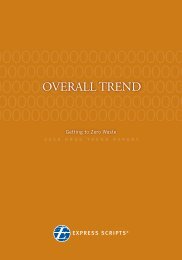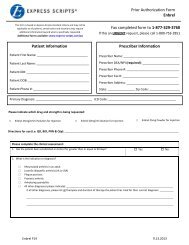Preferred Drug List 2013 Standard Formulary (3 ... - Express Scripts
Preferred Drug List 2013 Standard Formulary (3 ... - Express Scripts
Preferred Drug List 2013 Standard Formulary (3 ... - Express Scripts
You also want an ePaper? Increase the reach of your titles
YUMPU automatically turns print PDFs into web optimized ePapers that Google loves.
DEVELOPMENT OF THE DRUG FORMULARY<br />
The <strong>Drug</strong> <strong>Formulary</strong> is the cornerstone of drug therapy quality assurance and cost containment<br />
efforts. The <strong>Drug</strong> <strong>Formulary</strong> process has been successfully used by hospitals and managed care<br />
organizations to provide comprehensive, cost-effective pharmacy services.<br />
This <strong>Drug</strong> <strong>Formulary</strong> document was developed by the <strong>Express</strong> <strong>Scripts</strong>’ Pharmacy and Therapeutics<br />
Committee (P&T Committee). Arise Health Plan delegates this responsibility to ESI. The ESI P&T<br />
committee is comprised of physicians from various medical specialties and pharmacists.<br />
Medications are reviewed for safety, effectiveness, and cost. Then, the Committee selects<br />
the drugs considered to offer the greatest value in each category.<br />
<strong>Formulary</strong> development and maintenance is a dynamic process. The P&T Committee will regularly<br />
review new and existing medications to ensure the <strong>Formulary</strong> remains responsive to the needs of<br />
our members and providers.<br />
DRUG FORMULARY MEDICATIONS<br />
The <strong>Drug</strong> <strong>Formulary</strong> is a listing of medications marketed at the time of the<br />
<strong>Formulary</strong> printing, and intended for use by the health plan physicians and<br />
pharmacy providers. Unless exceptions are noted, all forms (tablet,<br />
capsule, liquid, topical) and strengths of a drug product are included in<br />
the <strong>Formulary</strong> and will be covered by the plan.<br />
The <strong>Drug</strong> <strong>Formulary</strong> applies to prescription medications dispensed to outpatients by participating<br />
pharmacies. The <strong>Formulary</strong> does not apply to inpatient medications or to most medications<br />
administered in a physician’s office.<br />
Non-Prescription Medication (OTC) Policy<br />
Over-the-counter (OTC) products are typically not covered, but some are listed for informational<br />
purposes. (When available, non-prescription products may be less costly to the patient than a<br />
covered product.) Also, if a prescription product is available in the identical strength, dosage form,<br />
and active ingredient(s) as an OTC product, the prescription product will not be covered. In these<br />
instances, physicians and pharmacists should refer members to the OTC equivalent product. If the<br />
member or physician insists on the prescription equivalent product, the member must pay the entire<br />
cost of the prescription.<br />
Generic <strong>Drug</strong> Policy<br />
If a member requests the brand name product in place of its generic equivalent, the patient must<br />
pay the applicable copay plus the cost difference between the brand name and generic drug.<br />
Prescriptions for Non-<strong>Formulary</strong> Medications<br />
Providers are requested to comply with the <strong>Drug</strong> <strong>Formulary</strong> when prescribing medications for plan<br />
members. If a pharmacist receives a prescription for a non-<strong>Formulary</strong> medication, the pharmacist<br />
may attempt to contact the physician to request a change to a <strong>Formulary</strong> product.



